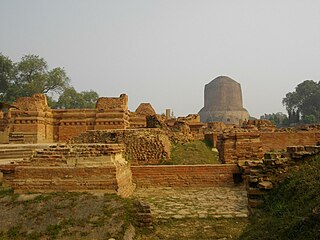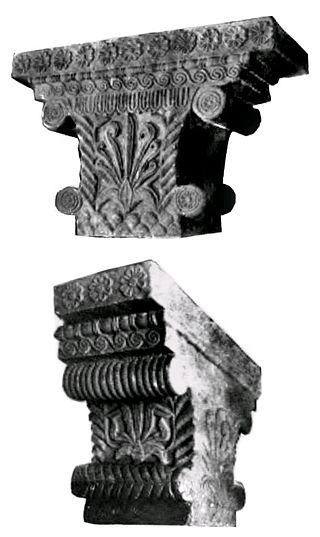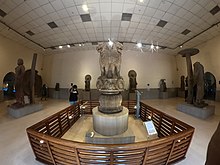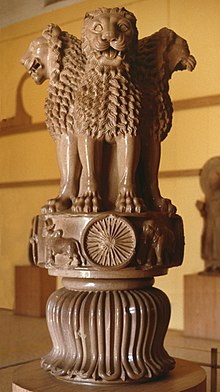
Sarnath is a place located 10 kilometres northeast of Varanasi, near the confluence of the Ganges and the Varuna rivers in Uttar Pradesh, India.

Sanchi Stupa is a Buddhist complex, famous for its Great Stupa, on a hilltop at Sanchi Town in Raisen District of the State of Madhya Pradesh, India. It is located, about 23 kilometers from Raisen town, district headquarter and 46 kilometres (29 mi) north-east of Bhopal, capital of Madhya Pradesh.

The Greco-Buddhist art or Gandhara art is the artistic manifestation of Greco-Buddhism, a cultural syncretism between Ancient Greek art and Buddhism. It had mainly evolved in the ancient region of Gandhara, located in the northwestern fringe of the Indian subcontinent.

The pillars of Ashoka are a series of monolithic pillars dispersed throughout the Indian subcontinent, erected—or at least inscribed with edicts—by the 3rd Mauryan Emperor Ashoka the Great, who reigned from c. 268 to 232 BC. Ashoka used the expression Dhaṃma thaṃbhā, i.e. "pillars of the Dharma" to describe his own pillars. These pillars constitute important monuments of the architecture of India, most of them exhibiting the characteristic Mauryan polish. Twenty of the pillars erected by Ashoka still survive, including those with inscriptions of his edicts. Only a few with animal capitals survive of which seven complete specimens are known. Two pillars were relocated by Firuz Shah Tughlaq to Delhi. Several pillars were relocated later by Mughal Empire rulers, the animal capitals being removed. Averaging between 12 and 15 m in height, and weighing up to 50 tons each, the pillars were dragged, sometimes hundreds of miles, to where they were erected.

Indian art consists of a variety of art forms, including painting, sculpture, pottery, and textile arts such as woven silk. Geographically, it spans the entire Indian subcontinent, including what is now India, Pakistan, Bangladesh, Sri Lanka, Nepal, Bhutan, and at times eastern Afghanistan. A strong sense of design is characteristic of Indian art and can be observed in its modern and traditional forms.

The dharmachakra or wheel of dharma is a widespread symbol used in Buddhism. The symbol also finds usage in Hinduism, particularly in places that underwent religious transformation, and in Jainism and in modern India.

Buddhist art is visual art produced in the context of Buddhism. It includes depictions of Gautama Buddha and other Buddhas and bodhisattvas, notable Buddhist figures both historical and mythical, narrative scenes from their lives, mandalas, and physical objects associated with Buddhist practice, such as vajras, bells, stupas and Buddhist temple architecture. Buddhist art originated in the north of the Indian subcontinent, in modern India, Pakistan and Afghanistan, with the earliest survivals dating from a few centuries after the historical life of Siddhartha Gautama from the 6th to 5th century BCE.

Sculpture in the Indian subcontinent, partly because of the climate of the Indian subcontinent makes the long-term survival of organic materials difficult, essentially consists of sculpture of stone, metal or terracotta. It is clear there was a great deal of painting, and sculpture in wood and ivory, during these periods, but there are only a few survivals. The main Indian religions had all, after hesitant starts, developed the use of religious sculpture by around the start of the Common Era, and the use of stone was becoming increasingly widespread.

The Lion Capital of Ashoka is the capital, or head, of a column erected by the Mauryan emperor Ashoka in Sarnath, India, c. 250 BCE. Its crowning features are four life-sized lions set back to back on a drum-shaped abacus. The side of the abacus is adorned with wheels in relief, and interspersing them, four animals, a lion, an elephant, a bull, and a galloping horse follow each other from right to left. A bell-shaped lotus forms the lowest member of the capital, and the whole 2.1 metres (7 ft) tall, carved out of a single block of sandstone and highly polished, was secured to its monolithic column by a metal dowel. Erected after Ashoka's conversion to Buddhism, it commemorated the site of Gautama Buddha's first sermon some two centuries before.

Around 535 BCE, the Persian king Cyrus the Great initiated a protracted campaign to absorb parts of India into his nascent Achaemenid Empire. In this initial incursion, the Persian army annexed a large region to the west of the Indus River, consolidating the early eastern borders of their new realm. With a brief pause after Cyrus' death around 530 BCE, the campaign continued under Darius the Great, who began to re-conquer former provinces and further expand the Achaemenid Empire's political boundaries. Around 518 BCE, the Persian army pushed further into India to initiate a second period of conquest by annexing regions up to the Jhelum River in what is today known as Punjab. At peak, the Persians managed to take control of most of modern-day Pakistan and incorporate it into their territory.
Buddhavanam is a tourism project in Nagarjuna Sagar, Telangana created by the Telangana State Tourism Development Corporation. The project was sanctioned by the Government of India viz., Integrated Development of Nagarjunasagar as part of Lower Krishna valley Buddhist circuit with a view to attract large number of domestic and foreign tourists particularly from the South-East Asian countries.

Hellenistic influence on Indian art and architecture reflects the artistic and architectural influence of the Greeks on Indian art following the conquests of Alexander the Great, from the end of the 4th century BCE to the first centuries of the common era. The Greeks in effect maintained a political presence at the doorstep, and sometimes within India, down to the 1st century CE with the Greco-Bactrian Kingdom and the Indo-Greek Kingdoms, with many noticeable influences on the arts of the Maurya Empire especially. Hellenistic influence on Indian art was also felt for several more centuries during the period of Greco-Buddhist art.

The Art of Mathura refers to a particular school of Indian art, almost entirely surviving in the form of sculpture, starting in the 2nd century BCE, which centered on the city of Mathura, in central northern India, during a period in which Buddhism, Jainism together with Hinduism flourished in India. Mathura "was the first artistic center to produce devotional icons for all the three faiths", and the pre-eminent center of religious artistic expression in India at least until the Gupta period, and was influential throughout the sub-continent.
The culture of Magadh is rich with its distinct language, folk songs and festivals. In ancient period it was known as Magadha mahajanpada. The present-day Magadh region split between the states of Bihar and Jharkhand, India. The major language of the region is Magahi.

Mauryan polish describes one of the frequent characteristics of architecture and sculptures of the Maurya Empire in India, which gives a very smooth and shiny surface to the stone material, generally of sandstone or granite. Mauryan polish is found especially in the Ashoka Pillars as well as in some constructions like the Barabar Caves. The technique did not end with the empire, but continued to be "used on occasion up to the first or second century A.D.", although the presence of the polish sometimes complicates dating, as with the Didarganj Yakshi. According to the archaeologist John Marshall: the "extraordinary precision and accuracy which characterizes all Mauryan works, and which has never, we venture to say, been surpassed even by the finest workmanship on Athenian buildings".

The Masarh lion is a stone sculpture found at Masarh, a village near Arrah town in the Bhojpur district of the Indian state of Bihar. This sculpture is generally dated to the 3rd century B.C.

Ancient Indian architecture ranges from the Indian Bronze Age to around 800 CE. By this endpoint Buddhism in India had greatly declined, and Hinduism was predominant, and religious and secular building styles had taken on forms, with great regional variation, which they largely retain even after some forceful changes brought about by the arrival of first Islam, and then Europeans.

Gupta art is the art of the Gupta Empire, which ruled most of northern India, with its peak between about 300 and 480 CE, surviving in much reduced form until c. 550. The Gupta period is generally regarded as a classic peak and golden age of North Indian art for all the major religious groups. Gupta art is characterized by its "Classical decorum", in contrast to the subsequent Indian medieval art, which "subordinated the figure to the larger religious purpose".

Kushan art, the art of the Kushan Empire in northern India, flourished between the 1st and the 4th century CE. It blended the traditions of the Greco-Buddhist art of Gandhara, influenced by Hellenistic artistic canons, and the more Indian art of Mathura. Kushan art follows the Hellenistic art of the Greco-Bactrian Kingdom as well as Indo-Greek art which had been flourishing between the 3rd century BCE and 1st century CE in Bactria and northwestern India, and the succeeding Indo-Scythian art. Before invading northern and central India and establishing themselves as a full-fledged empire, the Kushans had migrated from northwestern China and occupied for more than a century these Central Asian lands, where they are thought to have assimilated remnants of Greek populations, Greek culture, and Greek art, as well as the languages and scripts which they used in their coins and inscriptions: Greek and Bactrian, which they used together with the Indian Brahmi script.

The Buddha Preaching his First Sermon is a stone sculpture of the 5th-century CE showing Gautama Buddha in the "teaching posture" or dharmachakra pravartana mudrā. The relief is 5' 3" tall, and was excavated at Sarnath, India by F. O. Oertel during the 1904–1905 excavation season of the Archaeological Survey of India (ASI); it was found in an area to the south of the Dhamek Stupa.
























